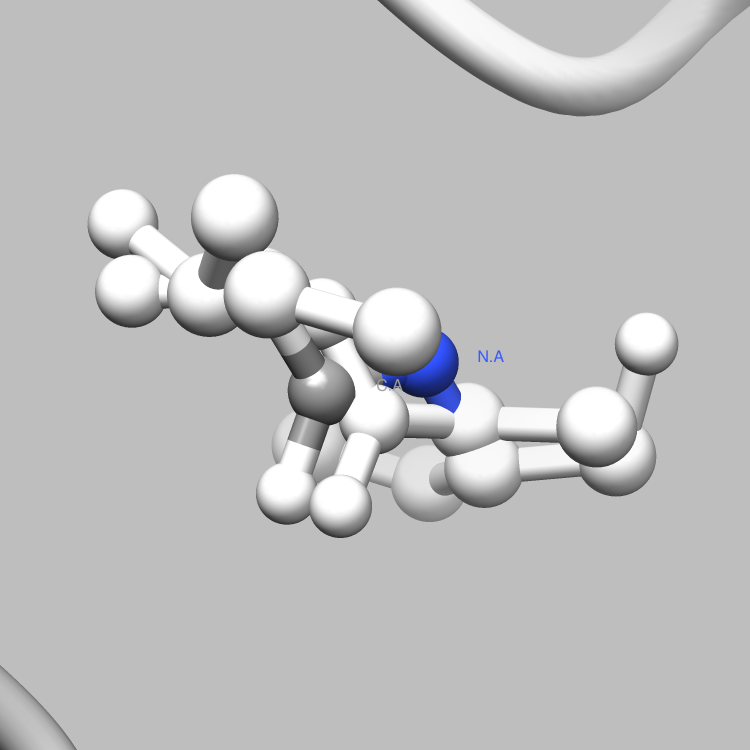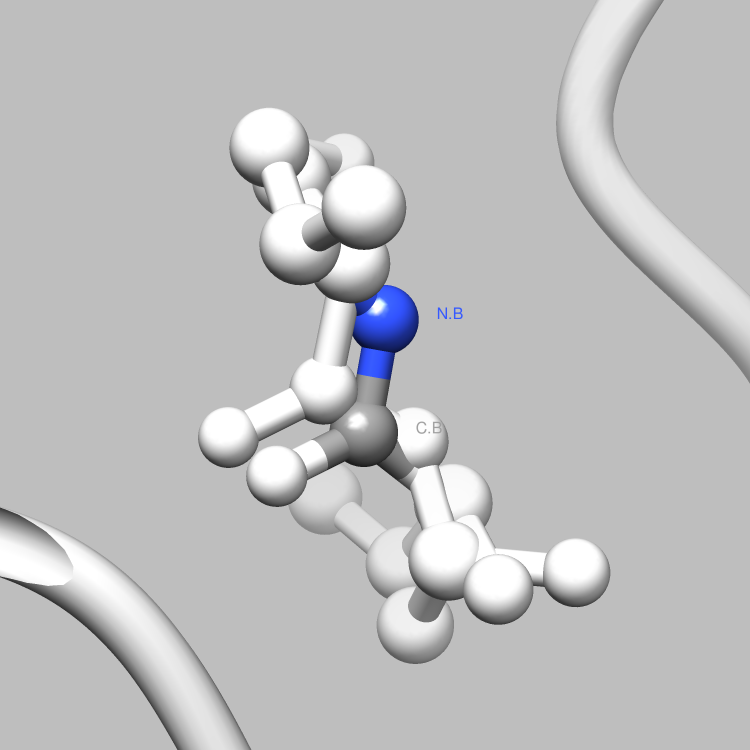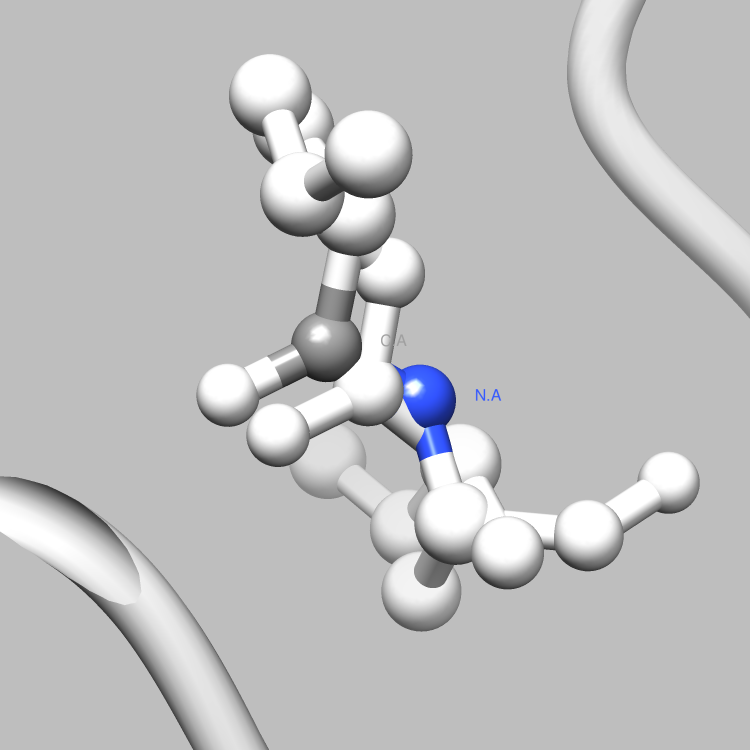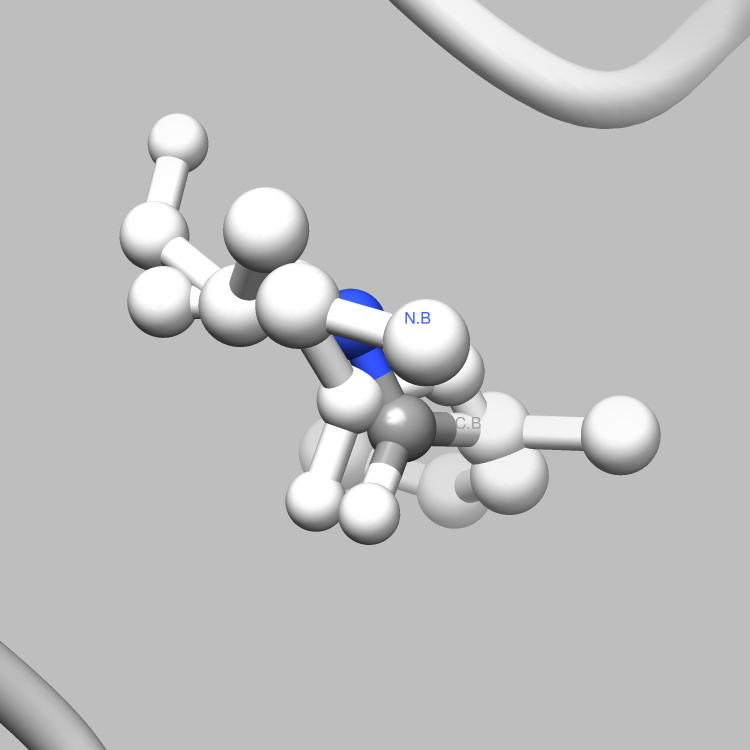C++ Example Connections2.C
ABOUT THIS EXAMPLE:
This example is one of a few that shows how the CIFPARSE-OBJ library can be used to interface with Chimera, such that useful and interesting aspects of a molecule, e.g., certain connections among certain atoms, obtainable via parsing CIF files, can be located and used as the subject of a Chimera render or animation. This particular example shows how to find connections of certain types that involve certain entities by retrieving and iterating over the struct_conn category, which delineates connections in a molecule, and using the struct_asym and entity categories to determine the entity types involved in each connection. In this case, polymer-polymer covalent bonds are sought for Chimera to emphasize and animate. It is easy to extend this example, say, to handle a set of connection types of interest involving certain entity pairings, each to be displayed in a different color in Chimera, or to focus on connection types of interest only among certain atoms and entities of interest.
Build Instructions:
Files: Connections2.C, 5HVP.cif, Connections2.sh
Save Connections2.C to/path/to/cifparse-obj-vX.X-prod-src/parser-test-app-vX.X/src/Save the CIF file anywhere, e.g.,/path/to/cifparse-obj-vX.X-prod-src/parser-test-app-vX.X/bin/Add Connections2.ext to the BASE_MAIN_FILES list in the Makefile in/path/to/cifparse-obj.vX.X-prod-src/parser-test-app-vX.XExecutemakein the same directory as the Makefilecdto bin, where the executable has been made, and run./Connections2 /path/to/5HVP.cif, which generates a/path/to/5HVP.comfile which you can open withchimera /path/to/5HVP.comAlternatively, you can save the script to/path/to/cifparse-obj-vX.X-prod-src/parser-test-app-vX.X/bin/, set the Chimera path, and run./Connections2.sh /path/to/5HVP.cif, which will automate the process
Functions to Note
#include "CifFile.h"
- string CifFile::GetFirstBlockName() ►
- Returns the first data block name. CifFile inherits this method from TableView.
Related:
CifFile::GetBlockNames(vector<string>& blockNames). - Block& CifFile::GetBlock(const string& blockName) ►
- Retrieves a data block specified by some blockName. CifFile inherits this method from TableView.
- ISTable& Block::GetTable(const string& name) ►
- Retrieves a table (i.e., category) within the block, specified by some name.
#include "ISTable.h"
- unsigned int ISTable::GetNumRows() ►
- Returns the numbers of rows in the table (i.e., category).
- const string& operator()(const unsigned int rowIndex, const string colName) ►
- Returns the value of the attribute colName at row index rowIndex
Covalent Polymer-Polymer Linkages for 5HVP.cif
Molecular Graphics from Chimera
/*************************
* Connections2.C
*
* For some CIF file, generate a Chimera command (COM) file
* to iterate through and emphasize connections of specific connection types
* and involving specific types of entities. As an example, we will
* look for polymer-polymer covalent linkages.
*
* Method: For connections of interest, determine each partner atom's entity
* type by indexing into the struct_asym category table with the atom's asym_id to
* determine its entity ID. Then, index into the entity category table to
* determine its entity type.
*
* Lines with superscriptions contain footnoted references or explanations.
*************************/
#include <cstring>
#include <fstream>
#include <iostream>
#include <map>
#include <string>
#include <vector>
#include "CifFile.h"
#include "CifParserBase.h"
#include "ISTable.h"
void prepareOutFile(std::ofstream& outFile, const string& outFileName);
void showUsage();
void writeConnection(std::ofstream& outFile, const string& select);
int main(int argc, char **argv)
{
if (argc != 2)
{
showUsage();
}
// The name of the CIF file
string cifFileName = argv[1];
// A string to hold any parsing diagnostics
string diagnostics;
// Create CIF file and parser objects
CifFile *cifFileP = new CifFile;
CifParser *cifParserP = new CifParser(cifFileP);
// Parse the CIF file
cifParserP->Parse(cifFileName, diagnostics);
// Delete the CIF parser, as it is no longer needed
delete cifParserP;
// Display any diagnostics
if (!diagnostics.empty())
{
std::cout << "Diagnostics: " << std::endl << diagnostics << std::endl;
}
// Get the first data block name in the CIF file
string firstBlockName = cifFileP->GetFirstBlockName();
// Retrieve the first data block
Block &block = cifFileP->GetBlock(firstBlockName);
// Retrieve the table corresponding to the struct_conn category, which delineates connections1
ISTable& struct_conn = block.GetTable("struct_conn");
// Retrieve the table corresponding to the struct_asym category, which
// details structural elements in the asymmetric unit2
ISTable& struct_asym = block.GetTable("struct_asym");
// Retrieve the table corresponding to the entity category, which details the
// molecular entities present in the crystallographic structure3
ISTable& entity = block.GetTable("entity");
// Use the CIF file name to generate the Chimera command file (.COM) name
size_t fileExtPos = cifFileName.find(".cif");
string outFileName = cifFileName.substr(0, fileExtPos) + ".com";
// Create the command file
std::ofstream outFile;
outFile.open(outFileName.c_str());
// Write out some basic Chimera initialization commands
prepareOutFile(outFile, cifFileName);
// Iterate through every row in the struct_conn category table, where each row delineates an interatomic connection
for (unsigned int i = 0; i < struct_conn.GetNumRows(); ++i)
{
// We are only interested in checking the entity types for covalent linkages4
if (struct_conn(i, "conn_type_id") != "covale")
{
continue;
}
// Holds each partner atom's entity type
string entityTypes[2];
// A Chimera selection string for the two partner atoms
string select;
// Analyze the current row twice, once per partner
for (unsigned int j = 0; j < 2; ++j)
{
// Determine which partner we are dealing with
string partner = (!j) ? "ptnr1_" : "ptnr2_";
// Retrieve all the information necessary to uniquely identify that partner atom5
string alt_id = struct_conn(i, "pdbx_" + partner + "label_alt_id");
string asym_id = struct_conn(i, partner + "auth_asym_id");
string atom_id = struct_conn(i, partner + "label_atom_id");
string comp_id = struct_conn(i, partner + "auth_comp_id");
string seq_id = struct_conn(i, partner + "auth_seq_id");
// Add to the Chimera selection string for this atom6
select += ":" + seq_id + "," + comp_id + "." + asym_id + "@" + atom_id + "." + alt_id;
// Add an OR to the selection string before partner 2 so that Chimera grabs both partner atoms
if (!j)
{
select += " | ";
}
// Holds the atom's entity ID, which we will find in the struct_asym category table
unsigned int entityID (0);
// Iterate over every row in the struct_asym category table
for (unsigned int k = 0; k < struct_asym.GetNumRows(); ++k)
{
// Check that we have the right asym_id
if (struct_asym(k, "id") == asym_id)
{
// Retrieve the entity ID
entityID = atoi(struct_asym(k, "entity_id").c_str());
// Finished looking
break;
}
}
// Retrieve and store the entity type (subtract 1 because the rows are zero-indexed)
entityTypes[j] = entity(entityID - 1, "type");
}
// Write satisfactoy entity pairings to the COM file (in this case polymer-polymer)
if (entityTypes[0] == "polymer" && entityTypes[1] == "polymer")
{
writeConnection(outFile, select);
}
}
// Write out the Chimera close command
outFile << "stop\n";
// Close the COM file as all connections have been processed
outFile.close();
return 0;
}
void prepareOutFile(std::ofstream& outFile, const string& outFileName)
{
outFile << "windowsize 500 500\n"; // Set the window size to 500 x 500 px
outFile << "open " + outFileName + "\n"; // Open the CIF file
outFile << "preset apply pub 4\n"; // Apply publication preset #4
outFile << "color white\n"; // Color the entire molecule white
outFile << "set bg_color gray\n"; // Color the background gray
outFile << "repr bs\n"; // Represent the atoms in ball-and-stick format
outFile << "savepos fullview\n"; // Remember this position (the full view of the molecule)
}
void showUsage()
{
std::cout << "Usage: ./Connections2 /path/to/file.cif" << std::endl;
exit(1);
}
void writeConnection(std::ofstream& outFile, const string& select)
{
outFile << "sel " + select << std::endl; // Select the two partner atoms
outFile << "color byelement sel; label sel\n"; // Color them yellow
outFile << "sel sel za<3.0; wait 20\n"; // Further select all atoms within 3.0 angstroms of the partner atoms
outFile << "focus sel; wait 25; ~disp ~sel; wait 68\n"; // Focus on the selection and hide all non-selected atoms
outFile << "disp ~sel; ~label sel; reset fullview 20\n"; // Return to the full molecule view
outFile << "color white sel; ~sel; wait 20\n"; // Uncolor and drop the selection
}






